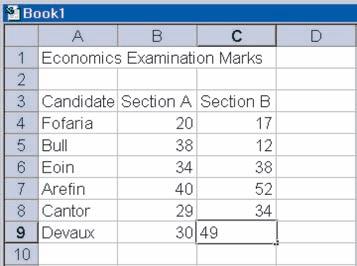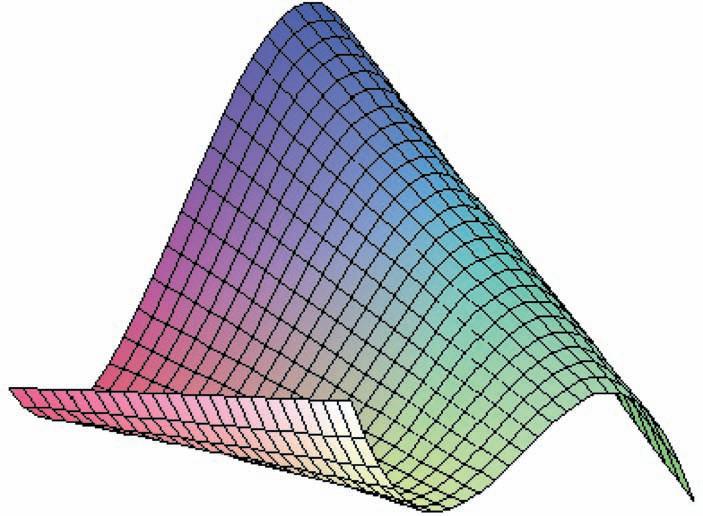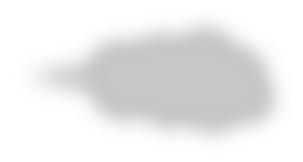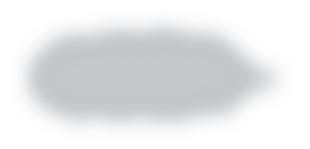SolutionstoProblems
Getting Started
1 (a) This is shown in Figure SI.1.

(e) Just put the cursor over cell C5 and type in the new mark of 42. Pressing the Enter key causes cells D5 and D10 to be automatically updated. The new spreadsheet is shown in Figure SI.3.

(b) Type the heading Total Mark in cell D3. Type =B4+C4 into cell D4. Click and drag down to D9.


(c) Type the heading Average: in cell C10. Type =(SUM 4:D9))/6 in cell D10 and press Enter.
[Note: Excel has lots of built-in functions for performing standard calculations such as this. To find the average you could just type =AVERAGE(D4:D9) in cell D10.]
(d) This is shown in Figure SI.2.
2 (a) 14
(b) 11
(c) 5
3 (a) 4; is the solution of the equation 2x 8 = 0
(b) Figure SI.4 shows the graph of 2x 8 plotted between x = 0 and 10.

(c) x2 + 4x + 4; the brackets have been ‘multiplied out’ in the expression (x + 2)2
(d) 7x + 4; like terms in the expression 2x + 6 + 5x 2 have been collected together.
(e) Figure SI.5 shows the three-dimensional graph of the surface x3 3x + xy plotted between 2 and 2 in both the x and y directions.
Figure SI.1
Figure SI.3
Figure SI.4
Figure SI.2
3 (a) 3 (b) 2 (c) 18 (d) 15
(e) 41 (f) 3 (g) 18 (h) 6
(i) 25 (j) 6
4 (a) 2PQ (b) 8I (c) 3xy
(d) 4qwz (e) b2 (f) 3k2
5 (a) 19w (b) 4x 7y (c) 9a + 2b 2c
(d) x2 + 2x (e) 4c 3cd (f) 2st + s2 + t2 + 9
6 (a) 10 (b) 18 (c)
Chapter 1
Section 1.1
Practice Problems
1 (a) 30 (b) 2 (c) 5
(d) 5 (e) 36 (f) 1

2 (a) 1 (b) 7 (c) 5
(d) 0 (e) 91 (f) 5
3 (a) 19 (b) 1500 (c) 32 (d) 35
4 (a) x + 9y (b) 2y + 4z (c) Not possible.
(d) 8r2 + s + rs 3s2 (e) 4f
(f) Not possible. (g) 0
5 (a) 5z 2z 2
(b) 6x 6y + 3y 6x =−3y
(c) x y + z x2 x + y = z x2
6 (a) 7(d + 3) (b) 4(4w 5q)
(c) 3(3x y + 3z) (d) 5Q(1 2Q)
7 (a) x2 2x + 3x 6 = x2 + x 6
(b) x2 xy + yx y2 = x2 y2
(c) x2 + xy + yx + y2 = x2 + 2xy + y2
(d) 5x2 5xy + 5x + 2yx 2y2 + 2y
= 5x2 3xy + 5x 2y2 + 2y
8 (a) (x + 8)(x 8)
(b) (2x + 9)(2x 9)
Exercise 1.1 (p. 30)
1 (a) 20 (b) 3 (c) 4 (d) 1
(e) 12 (f) 50 (g) 5 (h) 3
(i) 30 (j) 4
2 (a) 1 (b) 3 (c) 11 (d) 16
(e) 1 (f) 13 (g) 11 (h) 0
(i) 31 (j) 2
(b) Presented with the calculation, 42, your calculator uses BIDMAS, so squares first to get 16 and then subtracts from zero to give a final answer, 16. To obtain the correct answer you need to use
= x2 ) 4 (
(d) 6xyz + 2xy (e) 10a 2b (f) 17x + 22y
(g) 11 3p (h) x2 + 10x
15 (a) (x + 2)(x 2) (b) (Q + 7)(Q 7)
(c) (x + y)(x y) (d) (3x + 10y)(3x 10y)
16 (a) 4x2 + 8x 2 (b) 13x
Exercise 1.1* (p. 32)
1 (a) 3 (b) 5 (c) 7
2 (a) 2 7 (9 + 3) =−17 (b) 8 (2 + 3) 4 =−1
(c) 7 (2 6 + 10) = 1
3 (a) 6 (b) 6 (c) 5 (d) 96
(e) 1 (f) 6 (g)(h) 63
5 4
4 (a) 6 (b) 2 (c) 5
5 y2 + xy 5x + 2y 6
SOLUTIONS TO PROBLEMS 657
2000 (d) 96 (e)
7 (a) 1 (b) 5 (c) 6 (d) 6 (e) 30 (f) 44 8 (a)
70
16
brackets: 9 (a) 9 (b) 21; no 10 (a) 43.96 (b) 1.13 (c) 10.34 (d) 0.17 (e) 27.38 (f) 3.72 (g) 62.70 (h) 2.39 11 (a) 7x 7y (b) 15x 6y (c) 4x + 12 (d) 21x 7 (e) 3x + 3y + 3z (f) 3x2 4x (g) 2x 5y + 4z 12 (a) 5(5c + 6) (b) 9(x 2) (c) x(x + 2) (d) 4(4x 3y) (e) 2x(2x 3y) (f) 5(2d 3e + 10) 13 (a) x2 + 7x + 10 (b) a2 + 3a 4 (c) d2 5d 24 (d) 6s2 + 23s + 21 (e) 2y2 + 5y + 3 (f) 10t2 11t 14 (g) 9n2 4 (h) a2 2ab + b2 14 (a) 6x + 2y (b) 11x2 3x 3 (c) 14xy + 2x;
Figure SI.5
658 SOLUTIONS TO PROBLEMS
(b) 3(3 2x) + 2(x 1) = 10
9 6x + 2x 2 = 10 (multiply out brackets)
7 4x = 10 (collect like terms)
4x = 3 (subtract 7from both sides)
x =− (divide both sides by 4)
Section 1.2
Practice Problems
(c) = 5
4 = 5(x 1) (multiply both sides by x 1)
4 = 5x 5 (multiply out brackets)
9 = 5x (add 5 to both sides)
= x (divide both sides by 5)
(d) =
3(x 1) = 5x (cross-multiplication)
3x 3 = 5x (multiply out brackets)
3 = 2x (subtract 3x from both sides)
−= x (divide both sides by 2)
6 (a) 12 > 9 (true) (b) 12 > 6 (true)
(c) 3 > 0 (true) (d) same as (c)
(e) 2 > 1 (true) (f) 24 >−12 (false)
(g) 6 >−3 (false) (h) 2 >−1 (false)
(i) 4 >−7 (true)
x < 7 (subtract 3x from both sides)
x >−7 (divide both sides by 1 changing sense because 1 < 0)
(b) 21x 19 ≥ 4x + 15
17x 19 ≥ 15 (subtract 4x from both sides)
17x ≥ 34 (add 19 to both sides)
x ≥ 2 (divide both sides by 17, leaving inequality unchanged because 17 > 0)
Exercise 1.2 (p. 47)
=
6 (a) 2x 2y (b) 2x (c) 2x + 3y 7 (a) x2 2x 24 (b) 6x2 29x + 35 (c) 6x2 + 2xy 4x (d) 12 2g + 3h 2g2 + gh (e) 2x 2x2 3xy + y y2 (f) a2 b2 c2 2bc 8 (a) 3(3x 4y) (b) x(x 6) (c) 5x(2y + 3x) (d) 3xy( y 2x + 4) (e) x2(x 2) (f) 5xy3(12x3y3 3xy + 4) 9 (a) ( p + 5)( p 5) (b) (3c + 8)(3c 8) (c) 2(4v + 5d)(4v 5d) (d) (4x2 + y2)(2x + y)(2x y) 10 (a) 112600000 (b) 1.7999 (c) 283400 (d) 246913577
1 (a)(b)(c)(d)(e) 2 (a) ×== (b) 7 ×= (c) ÷=×= (d) ÷ 16 =×= 3 (a) −= (b) +=+= (c) −=−= 4 (a) ×= (b) ÷=×= (c) +== (d) =− == 5 (a) 4x + 5 = 5x 7 5 = x 7 (subtract 4x from both sides) 12 = x (add 7 to both sides) (x + 3) (x + 1)(x + 2) (2x + 4) (x + 1) (x + 1)(x + 2) (1)(x + 1) (x + 1)(x + 2) 2(x + 2) (x + 1)(x + 2) 1 x + 2 2 x + 1 5 x + 1 4 + 1 x + 1 1 x + 1 4 x + 1 x(x + 1) x + 10 x + 1 x x2 x + 10 x x + 1 x2 x + 10 5 x + 2 x 1 x + 2 5 x 1 5 36 9 36 14 36 1 4 7 18 11 15 6 15 5 15 2 5 1 3 2 7 1 7 3 7 1 18 1 16 2 1 8 9 8 9 3 4 9 3 8 4 2 3 8 9 2 3 1 2 1 142 3 8 1 × 3 2 × 4 3 4 1 2 1 x 4 1 2 + 3x 1 2y 4 5 3 5
7 (a) 2x < 3x + 7
2 4 = (x
x
1 x 2 2 3 e b 2a + 1 1 x 4 p 2q + 3r 3a 4b 2 3xy 1 ac 1 2x 2x 3 1 3 4 3 1 3 3 5 3 4 1 2 3 2 5 x 1 3 x 9 5 4 x 1 3 4
1 (a)(b)(c)(d)(e)
1 2 (a)(b)(c)(d)(e) 3 (a)(b)(c)(d) (e) (because x
+ 2)(
2))
4 == ; other two have no common factors on top and bottom.
5
Practice Problems
1
SOLUTIONS TO PROBLEMS 659
(a)(b)
(i)(j)(k)(l)
6 (a)(b)(c)(d) (e) 3 (f)(g)(h) (i)(j) 1 7 (a) 5 (b) 6 (c) 18 (d) 2 (e) 10 (f) 1 (g) 60 (h) 1 (i) 5 (j) 3 (k) 2 (l) 3 (m) 3 (n) 3 (o) 8 (a), (d), (e), (f) 9 (a) x > 1 (b) x ≥ 3 (c) x ≥−3 (d) x > 2 10 11 (a) (b) x ≤ 10 Exercise 1.2* (p. 48) 1 (a)(b)(c) 4 (d) 1 (e)(f)(g) (h) 2 (a)(b)(c)(d) (e)(f)(g)(h) (i) 6 (j)(k)(l) 4 3 (a) x + 6 (b) or equivalently 1 + (c)(d)(e)(f) (g)(h) x + 3 x(x + 1) x2 + x 2 x + 1 3x + 5 x2 7x + 3 x(x + 1) 5x + 2 6 5 xy 1 x x + 1 x 7 9 7 10 34 5 141 35 11 9 8 13 5 48 3 2 1 10 5 7 2x + 5y 3 1 2x2 5x + 3 x + 3 x + 4 1 x 6 3 2x 1 x 3 2 7 26 2 x3 1 4 1 4 2 3 2 3 t 20 18h2 7 x + 2 x + 3 15c + 10d 36 7y + 2x xy 3x 2 x2 2 5 1 x 1 2 21 2 2 27 1 30 7 12 2 5 5 8 5 6 7 18 7 20 5 6 1 3 3 7 1 2 x 1 2(x 1) x 1 2x 2 4 (a) (b) 1 (c) (d) 8 (e)(f)(g) (h) 8 (i) 9 (j)(k) 7 (l) 9 (m) 1 (n) 5 (o) 3 (p) 5 5 1.6 += 6.75;$7.21 6 (a) $3221.02 (b) $60000 (c) 10 7 (a) x <−8 (b) x >− (c) x ≤ 13 (d) x >−3 (e) 1 < x ≤ 3 8 3, 2, 1, 0. 9 (a)(b) 1 (c) x ≥ 10
1.3
(c)(d) (e)(f)(g)(h)
= 10
Section
From
S1.1
that all five points lie
a straight line. x(x 1) 2 11 5 3 2x 1 12 13 3 5 5x 7 71 21 11 7 1 4 4 5 35 9 11 7 2 PointCheck (1,2)2(1) + 3(2) =−2 + 6 = 4 3 (4,4)2(4) + 3(4) =−8 + 12 = 4 3 (5,2)2(5) + 3(2) = 106 = 4 3 (2,0)2(2) + 3(0) = 4 + 0 = 4 3
Figure
note
on
Figure S1.1
660 SOLUTIONS TO PROBLEMS





The graph is sketched in Figure S1.2. The graph shows that (3, 1) does not lie on the line. This can be verified algebraically:
2(3) + 3( 1) = 6 3 = 3 ≠ 4
4 x 2y = 2
0 2y = 2 (substitute x = 0)
2y = 2
y =−1 (divide both sides by 2)
Hence (0, 1) lies on the line.
x 2y = 2
x 2(0) = 2 (substitute y = 0)
x 0 = 2 x = 2
Hence (2, 0) lies on the line. The graph is sketched in Figure S1.4.
3 3x 2y = 4
3(2) 2y = 4 (substitute x =−2)

6 2y = 4
2y =−2 (subtract 6 from both sides)

y = 1 (divide both sides by 2)
Hence (2, 1) lies on the line.
3x 2y = 4
3( 2) 2y = 4
6 2y = 4 (substitute x = 2)
2y = 10 (add 6 to both sides)
y =−5 (divide both sides by 2)







Hence ( 2, 5) lies on the line.
The line is sketched in Figure S1.3.
 5 From Figure S1.5 the point of intersection is (1, 1/2).
Figure S1.2
Figure S1.3
Figure S1.4
Figure S1.5
5 From Figure S1.5 the point of intersection is (1, 1/2).
Figure S1.2
Figure S1.3
Figure S1.4
Figure S1.5
b








2. The graph is sketched in Figure S1.6.
(b) 4x + 2y = 1
2y = 1 4x (subtract 4x from both sides)

y = 1/2 2x (divide both sides by 2)
so a =−2, b = 1/2. The graph is sketched in Figure S1.7.
2 A, C, D, E
3 (a) 6 (b) 1; (6, 2), (1, 1)
4 xy 08 60 34
The graph is sketched in Figure S1.9.



Exercise 1.3 (p. 64)
1 From Figure S1.8 the point of intersection is (2, 3).
5
SOLUTIONS TO PROBLEMS 661
(a)
2, 2) (b) (2, 11/2) (c) (11/2, 1) (d) (10, 9)
(a) 5, 9 (b) 3, 1 (c) 1, 13 (d) 1, 4 (e) 2, (f) 5, 6 5 2
(
6
=
6 (a) a
1,
=
Figure S1.6
Figure S1.7
Figure S1.8
Figure S1.9
7 (a) The graph is sketched in Figure S1.10.
7 0, , , 0




Section 1.4
Practice Problems
1 (a) Step 1
It is probably easiest to eliminate y. This can be done by subtracting the second equation from the first:
3x 2y = 4 x 2y = 2
2x = 2
Step 2
The equation 2x = 2 has solution x = 2/2 = 1
(b) The graph is sketched in Figure S1.11.
Step 3
If this is substituted into the first equation then 3(1) 2y = 4 3 2y = 4
2y = 1 (subtract 3 from both sides)
y =−1/2 (divide both sides by 2)
Step 4
As a check the second equation gives x 2y = 1 2( 1/2)
= 1 ( 1) = 2 3
Hence the solution is x = 1, y =−1/2.
If you decide to eliminate x then the corresponding steps are as follows:
Step 1
Exercise 1.3* (p. 65)
1 (5, 2), (10, 1), (0, 5)
2 (a) (2, 5) (b) (1, 4) (c) ( 2, 3) (d) ( 8, 3)
3 (a) 7, 34 (b) 1, 1 (c) , 3
(d) 2, (e) , 0 (f) 0, 2
(g) The vertical line, x = 4, has no gradient and does not intercept the y axis.
4 (b) and (d)
5 (a) 0.5x + 70 (b) x + 20 (c) 100
6 (1) Gradients are and respectively so the lines are parallel when = which gives ae = bd.
(2) Parallel lines so no solution.
Triple the second equation and subtract from the first:
3x 2y = 4
3x 6y = 6 4y =−2
Step 2
The equation 4y =−2 has solution y =−2/4 =−1/2.
Step 3
If this is substituted into the first equation then 3x 2( 1/2) = 4 3x + 1 = 4 3x = 3
(subtract 1 from both sides) x = 1
(divide both sides by 3)
662 SOLUTIONS TO PROBLEMS
d e a b
e
b 1 5 5 2 3 2
d
a
D E F c a A B C D E F c b A B C
Figure S1.10
Figure S1.11
(b) Step 1
It is immaterial which variable is eliminated. To eliminate x multiply the first equation by 5, multiply the second by 3 and add:
15x + 25y = 95
15x + 6y =−33 + 31y = 62
Step 2
The equation 31y = 62 has solution y = 62/31 = 2
Step 3
If this is substituted into the first equation then
3x + 5(2) = 19
3x + 10 = 19
3x = 9 (subtract 10 from both sides) x = 3 (divide both sides by 3)
Step 4
As a check the second equation gives
5x + 2y =−5(3) + 2(2)
=−15 + 4 =−11 3
Hence the solution is x = 3, y = 2
2 (a) Step 1
To eliminate x multiply the first equation by 4, multiply the second equation by 3 and add:
12x + 24y =−8
12x + 24y =−3 + 0y =−11
Step 2
This is impossible, so there are no solutions.
(b) Step 1
To eliminate x multiply the first equation by 2 and add to the second:
10x + 2y = 8
10x 2y =−8 + 0y = 0
Step 2
This is true for any value of y, so there are infinitely many solutions.
3 Step 1
To eliminate x from the second equation multiply equation (2) by 2 and subtract from equation (1):
To eliminate x from the third equation multiply equation (1) by 3, multiply equation (3) by 2 and add:
The new system is
5(1)
Step 2
To eliminate y from the third equation multiply equation (4) by 2 and subtract equation (5): 8y 14z =−22 8y 11
The new system is
Step 3
Equation (6) gives z =−3/ 3 = 1. If this is substituted into equation (4) then 4y 7(1) =−11 4y 7 =−11
4y =−4 (add 7 to both sides)
y =−1 (divide both sides by 4)
Finally, substituting y =−1 and z = 1 into equation (1) produces
(divide both sides by 2)
Step 4
As a check the original equations (1), (2) and (3) give
+
=−5
SOLUTIONS TO PROBLEMS 663
2x + 2y 5z =−5 2x 2y + 2z = 6 4y 7z =−
11(4)
6x + 6y 15z =−15 6x + 2y + 4z =−4 + 8y 11z =−
19(5)
2x + 2y 5z =−
4y 7z =−
11(4) 8y 11z =−19(5)
z =−19 3z =−3(6)
2x + 2y 5z =−
4y 7z =−
3z =−
5(1)
11(4)
3(6)
2
1)
5 2x 7 =−5 2x = 2
x = 1
x + 2(
5(1) =−
(add 7 to both sides)
2(1)
z
2( 1) 5(1)
3 1 ( 1) + 1 = 3 3 3(1) + ( 1) + 2(1) =−2 3 Hence the solution is x = 1, y =−1,
= 1.
664 SOLUTIONS TO PROBLEMS

Exercise 1.4 (p. 77)
1 (a) x =−2, y =−2
(b) x = 2, y = 3/2
(c) x = 3/2, y = 1
(d) x = 10, y =−9
2 The lines are sketched in Figure S1.12.
(a) Infinitely many. (b) No solution.
2 The demand curve that passes through (0, 75) and (25, 0) is sketched in Figure S1.13. From this diagram we see that


3 (a) Infinitely many. (b) No solution.
4 k =−1
Exercise 1.4* (p. 78)
1 (a) x = 2, y = 5 (b) x = 1, y = 4
(c) x =−2, y = 3 (d) x =−8, y = 3
2 (a) a = 4, b = 8 (b) a =−3, b ≠
3 (a) x = 3, y =−2, z =−1
(b) x =−1, y = 3, z = 4
4 (a) No solution.
(b) Infinitely many solutions.
5 k = 6; no solutions otherwise.
Section 1.5
Practice Problems
1 (a) 0 (b) 48 (c) 16
(d) 25 (e) 1 (f) 17






The function g reverses the effect of f and takes you back to where you started. For example, if 25 is put into the function f, the outgoing number is 0; and when 0 is put into g, the original number, 25, is produced. We describe this by saying that g is the inverse of f (and vice versa).
(a) P = 6 when Q = 23
(b) Q = 19 when P = 18
Alternatively, using algebra:
(a) Substituting Q = 23 gives
P =−3(23) + 75 = 6
(b) Substituting P = 18 gives 18 =−3Q + 75 with solution Q = 19
3 (a) In equilibrium, QS = QD = Q, so
P =−4Q + 120

P = 1/3Q + 29
Hence
4Q + 120 = 1/3Q + 29
(since both sides equal P)
41/3Q + 120 = 29 (subtract 1/3Q from both sides)
41/3Q =−91 (subtract 120 from both sides)

Q = 21
(divide both sides by 41/3)
Substituting this value into either the demand or supply equations gives P = 36
(b) After the imposition of a $13 tax the supply equation becomes
P 13 = 1/3QS + 29
P = 1/3QS + 42
(add 13 to both sides)
1 2
Figure S1.12
Figure S1.13
The demand equation remains unchanged, so, in equilibrium,
P =−4Q + 120
P = 1/3Q + 42
Hence
4Q + 120 = 1/3Q + 42
This equation can now be solved as before to get Q = 18 and the corresponding price is P = 48. The equilibrium price rises from $36 to $48, so the consumer pays an additional $12. The remaining $1 of the tax is paid by the firm.
4 For good 1, QD1 = QS1 = Q1 in equilibrium, so the demand and supply equations become Q
Hence
40 5P1 P2 =−3 + 4P1 (since both sides equal Q1)
40 9P1 P2 =−3
(subtract 4P1 from both sides)
9P1 P2 =−43
(subtract 40 from both sides)
For good 2, QD2 = QS2 = Q2 in equilibrium, so the demand and supply equations become
Step 3
Substitute P2 into equation (1) to get P1 = 4
If these equilibrium prices are substituted into either the demand or the supply equations then Q1 = 13 and Q2 = 14.
The goods are complementary because the coefficient of P2 in the demand equation for good 1 is negative, and likewise for the coefficient of P1 in the demand equation for good 2.
Exercise 1.5 (p. 94)
1 (a) 21 (b) 45 (c) 15 (d) 2
(e) 10 (f) 0; inverse
2 The supply curve is sketched in Figure S1.14.
Hence
50 2P1 4P2 =−7 + 3P2 (since both sides equal Q2)
50 2P1 7P2 =−7

(subtract 3P2 from both sides)
2P1 7P2 =−57
(subtract 50 from both sides)
The equilibrium prices therefore satisfy the simultaneous equations
9P1 P2 =−43(1)
2P1 7P2 =−57(2)
Step 1
Multiply equation (1) by 2 and (2) by 9 and subtract to get
61P2 = 427(3)
Step 2
Divide both sides of equation (3) by 61 to get P2 = 7.
(a) 11 (b) 9
(c) 0; once the price falls below 7 the firm does not plan to produce any goods.
3 (a) Demand is 173. Additional advertising expenditure is 12.
(b) Superior.
4 (a) 53
(b) Substitutable; a rise in PA leads to an increase in Q
(c) 6
5 (a) 20, 10, 45;line passes through these three points.
(b) Line passing through (50, 0) and (0, 50)

Q = 20, P = 30
(c) Price increases; quantity increases.
6 6
7 P1 = 40, P2 = 10; Q1 = 30, Q2 = 55
8 (a) Q = 30
(b) Substitutable; e.g. since coefficient of Pr is positive.
(c) P = 14
SOLUTIONS TO PROBLEMS 665
2
1
3
1 = 40 5P1 + P
Q
=−
+ 4P1
2
2P1 + 4P2 Q2
7
3P2
Q
= 50
=−
+
Figure S1.14
(d)(i) slope =−20, intercept = 135
Section 1.6
(ii) slope =− , intercept = 6.75
1 20
9 Superior; graph of (b) lies above that of (a).
Substitutable; graph of (c) lies below that of (a).
Exercise 1.5* (p. 96)
1 (a) As PS rises, consumers are likely to switch to the good under consideration, so demand for this good also rises: that is, the graph shifts to the right.
(b) As PC rises, demand for the bundle of goods as a whole is likely to fall, so the graph shifts to the left.
(c) Assuming that advertising promotes the good and is successful, demand rises and the graph shifts to the right. For some goods, such as drugs, advertising campaigns are intended to discourage consumption, so the graph shifts to the left.
2 m =− , c = 9
3 0 and 30
4 (1) P = 30, Q = 10
(2) New supply equation is 0.85
Q = 9.28
5 (a) 17, 9 (b) $324
7 Change supply equation to P
3Q + 60 = 2Q + 40 + t
5Q =−20 + t
Q = 4
Substitute to get P = 48 + t
(a) t = 5 firm pays $2
(b) P = 45, Q = 5
8 $180, $200, .
(a)(b)(c) ; fraction is
When k = 6, the fraction is 3/4 so the consumer pays $45.
[In general, if the supply and demand equations are P =−aQD + b P = cQS + d
the fraction of tax paid by the consumer is
Practice Problems
1 (a) Q = 4 (subtract 13 from both sides)
Q = 8 (multiply both sides by 2)
(b) Q = P 13 (subtract 13 from both sides)
Q = 2(P 13) (multiply both sides by 2)
Q = 2P 26 (multiply out brackets)
(c) Q = 2 × 17 26 = 8
2 (a)
x2 = (divide both sides by 6)
x = (square root both sides)
(b) = y 7
1 = (reciprocate both sides)
7x =+ 1 (add 1 to both sides)
x =+ 1 (divide both sides by 7)
3 (a) x ay = cx + y
x = cx + y + ay
(add ay to both sides)
x cx = y + ay
(subtract cx from both sides)
(1 c)x = (1 + a)y
(factorize both sides)
x = y
(divide both sides by 1 c)
666
SOLUTIONS TO PROBLEMS
P = 2QS + 10; P = 33.6,
=
3 =
Q1 = 13, Q2 = 16, Q3 = 11
6 P1 = 20, P2
5, P
8;
= 2QS + 40 + t. In
equilibrium
.] a a + d k k + 2 2 3 3 5 1 2 1 3 3 5 t 5 3 2
6x2 = y
x
E F
+ a 1 c A B C D E F 1 y A B C 1 7 1 y 1 y 1 7x 1 y 6 y 6 1 2 1 2
D
1
(b) y = (x + 4)y = x 2 (multiply both sides by x + 4)
xy + 4y = x 2 (multiply out the brackets)
xy = x 2 4y (subtract 4y from both sides)
xy x =−2 4y (subtract x from both sides)
( y 1)x =−2 4y (factorize left-hand side)
x = (divide both sides by y 1)
Exercise 1.6 (p. 106) 1 Q =
Exercise 1.6* (p. 107) 1 (1) (a) (b) (c) (d) (e)
(2)(a) x = (b) x = 3 y (c) x =± (d) x = (e) x =±− 8
2 (a) x = (b) x = (c) x = (g − e)2 f
(d) x =+ n (e) x =+ m (f) x =
3 t = ; 11
4 r = 100
5 (a) G = Y(1 a + at) + aT b I
(b) T =
(c) t =
(d) a =
G + b + I Y(1 a + at)
G + b + I Y + aY aT
aY
G + b + I Y
T Y + tY
Section 1.7
Practice Problems
1 S = Y C = Y (0.8Y + 25) (substitute expression for C) = Y 0.8Y 25 (multiply out brackets) = 0.2Y 25 (collect terms)
2 Y = C + I (from theory)
C = 0.8Y + 25 (given in question)
I = 17 (given in question)
SOLUTIONS TO PROBLEMS 667
2 (a) y = 2x + 5 (b) y = 2(x + 5) (c) y = (d) y = 2(x + 4)2 3 3 (a) (b) (c) (d) (e) (f) (g) 4 (a) x = (y + 6) (b) x = 3y 4 (c) x = 2y (d) x = 5(y 8) (e) x =− 2 (f) x =+ 7 5 (a) P =− (b) Y = (c) P =− 6 x = 3 y + 2 b a 1 aQ b + 1 1 a b a Q a D E F 4 y A B C 1 3 1 y 1 9 5 x2 1 2 2 4y y 1 x 2 x + 4
P 4; 22
2
n 1
a D E F S P A B C V + 1 V 5 D E F a2 + b2 b a A B C n2 m2 ma2 b2 a2 b a + 1 c a b 4
y2
3 y + 8 5 y 1 9
y
5
Substituting the given value of I into the first equation gives
Y = C + 17
and if the expression for C is substituted into this then
Y = 0.8Y + 42
0.2Y = 42 (subtract 0.8Y from both sides)
Y = 210 (divide both sides by 0.2)
Repeating the calculations with I = 18 gives Y = 215, so a 1 unit increase in investment leads to a 5 unit increase in income. The scale factor, 5, is called the investment multiplier. In general, the investment multiplier is given by 1/(1 a), where a is the marginal propensity to consume. The foregoing is a special case of this with a = 0.8.
3 Y = C + I + G (1)
G = 40(2)


I = 55(3)
C = 0.8Yd + 25(4)
T = 0.1Y + 10(5)
Yd = Y T (6)
Substituting equations (2) and (3) into equation (1) gives
Y = C + 95(7)
Substituting equation (5) into (6) gives


Yd = Y (0.1Y + 10) = 0.9Y 10
so, from equation (4),
C = 0.8(0.9Y 10) + 25 = 0.72Y + 17(8)
Finally, substituting equation (8) into (7) gives
Y = 0.72Y + 112
which has solution Y = 400
4 The commodity market is in equilibrium when
Y = C + I
so we can substitute the given expressions for consumption (C = 0.7Y + 85) and investment (I = 50r + 1200) to deduce that
Y = 0.7Y 50r + 1285 which rearranges to give the IS schedule, 0.3Y + 50r = 1285(1)
The money market is in equilibrium when
MS = MD
Now we are given that MS = 500 and that total demand,
MD = L1 + L2 = 0.2Y 40r + 230
so that
500 = 0.2Y 40r + 230 which rearranges to give the LM schedule, 0.2Y 40r = 270(2)
We now solve equations (1) and (2) as a pair of simultaneous equations.
Step 1
Multiply equation (1) by 0.2 and (2) by 0.3 and subtract to get 22r = 176
Step 2
Divide through by 22 to get r = 8
Step 3
Substitute r = 8 into equation (1) to give Y = 2950.
The IS and LM curves shown in Figure S1.15 confirm this, since the point of intersection has coordinates (8, 2950). A change in I does not affect the LM schedule. However, if the autonomous level of investment increases from its current level of 1200 then the right-hand side of the IS schedule (1) will rise. The IS curve moves upwards, causing both r and Y to increase.
668 SOLUTIONS TO PROBLEMS
Exercise 1.7 (p. 123) 1 (a) 40 (b) 0.7; Y = (C 40); 100 2 (a) S = 0.1Y 72 (b) S = 0.2Y 100 3 (a) 325 (b) 225 (c) 100 10 7
Figure S1.15
4 10a + b = 28 30a + b = 44
a = 0.8, b = 20; Y = 165
5 187.5
Exercise 1.7* (p. 124)
1 (a) S = 0.3Y 30
(b) S =
2 C =
3 a =
4 825
5 Y = 2500, r = 10
6 C = a(Y 20) + 50 = aY 20a + 50
Y = aY 20a + 74
(1 a)Y = 74 20a ⇒ Y =
a = ; a = 0.6, C = 131
7 (a) C = 120 + 0.8Y
(b) C = 40 + 0.8Y
(c) C = 120 + 0.6Y
With a lump sum tax, the graph has the same slope but has been shifted downwards.
With a proportional tax, the graph has the same intercept but is less steep.
(a) 600 (b) 200 (c) 300
8 0.9Y + 30; 300
(a) Slope decreases; 150.
(b) Shifts up 5 units; 350.
Chapter 2
Section 2.1
Practice Problems
(c) x2 3 = 0
x2 = 3
x =± 3
x =±1.73 (to 2 decimal places)
(d) x2 5.72 = 0
x2 = 5.72
x =± 5.72
x =±2.39 (to 2 decimal places)
(e) x2 + 1 = 0
x2 =−1
This equation does not have a solution, because the square of a number is always positive. Try using your calculator to find ( 1) . An error message should be displayed.
(f) 3x2 + 6.21 = 0
3x2 =−6.21
x2 =−2.07
This equation does not have a solution, because it is impossible to find the square root of a negative number.
(g) x2 = 0
This equation has exactly one solution, x = 0
This equation has two solutions:
This equation has one solution,
SOLUTIONS TO PROBLEMS 669
x2 =
x =± 100 x =±10
2x2 8 = 0 2x2 = 8 x2 = 4 x =± 4 x =±2 Y
Y
74
1 a Y b I * Y aI* + b 1
10Y 500 Y + 10
1 (a) x2 100 = 0
100
(b)
74
20
20a
a
2 (a) a = 2, b =−19, c =−10 x = = ==
x == 10 x ==− (b) a = 4, b = 12, c = 9 x = = =
x
3/2. 12 ± 0 8 12 ± (144 144) 8 12 ± ((12)2 4(4)(9)) 2(4) 1 2 19 21 4 19 + 21 4 19 ± 21 4 19 ± 441 4 19 ± (361+ 80) 4 ( 19) ± (( 19)2 4(2)( 10)) 2(2)
=−




















 5 From Figure S1.5 the point of intersection is (1, 1/2).
Figure S1.2
Figure S1.3
Figure S1.4
Figure S1.5
5 From Figure S1.5 the point of intersection is (1, 1/2).
Figure S1.2
Figure S1.3
Figure S1.4
Figure S1.5



























